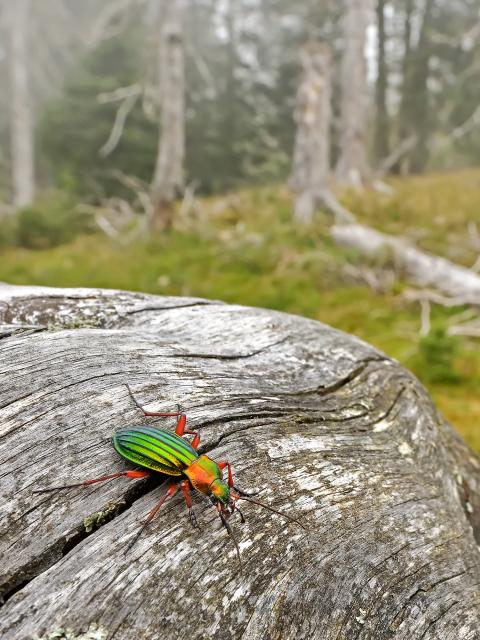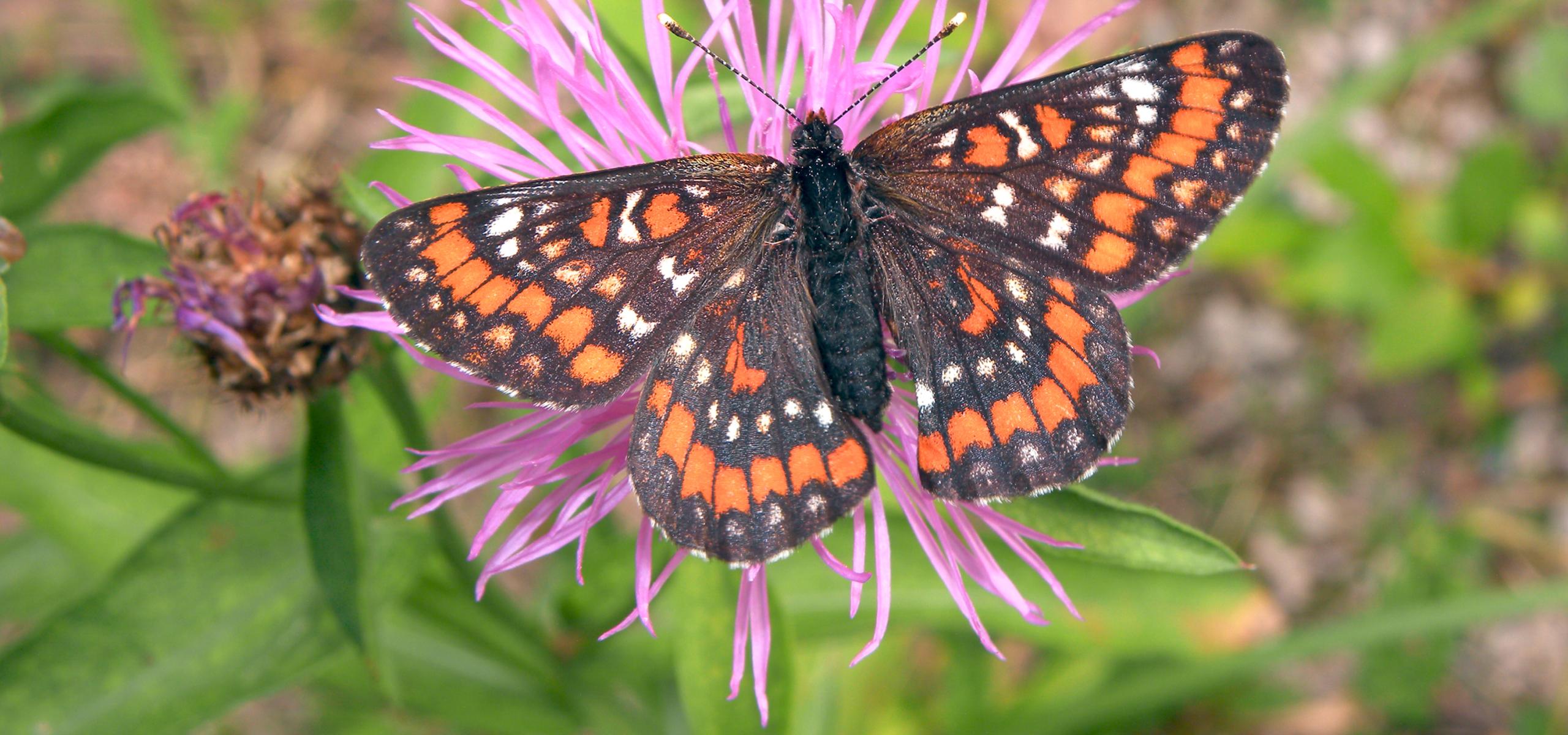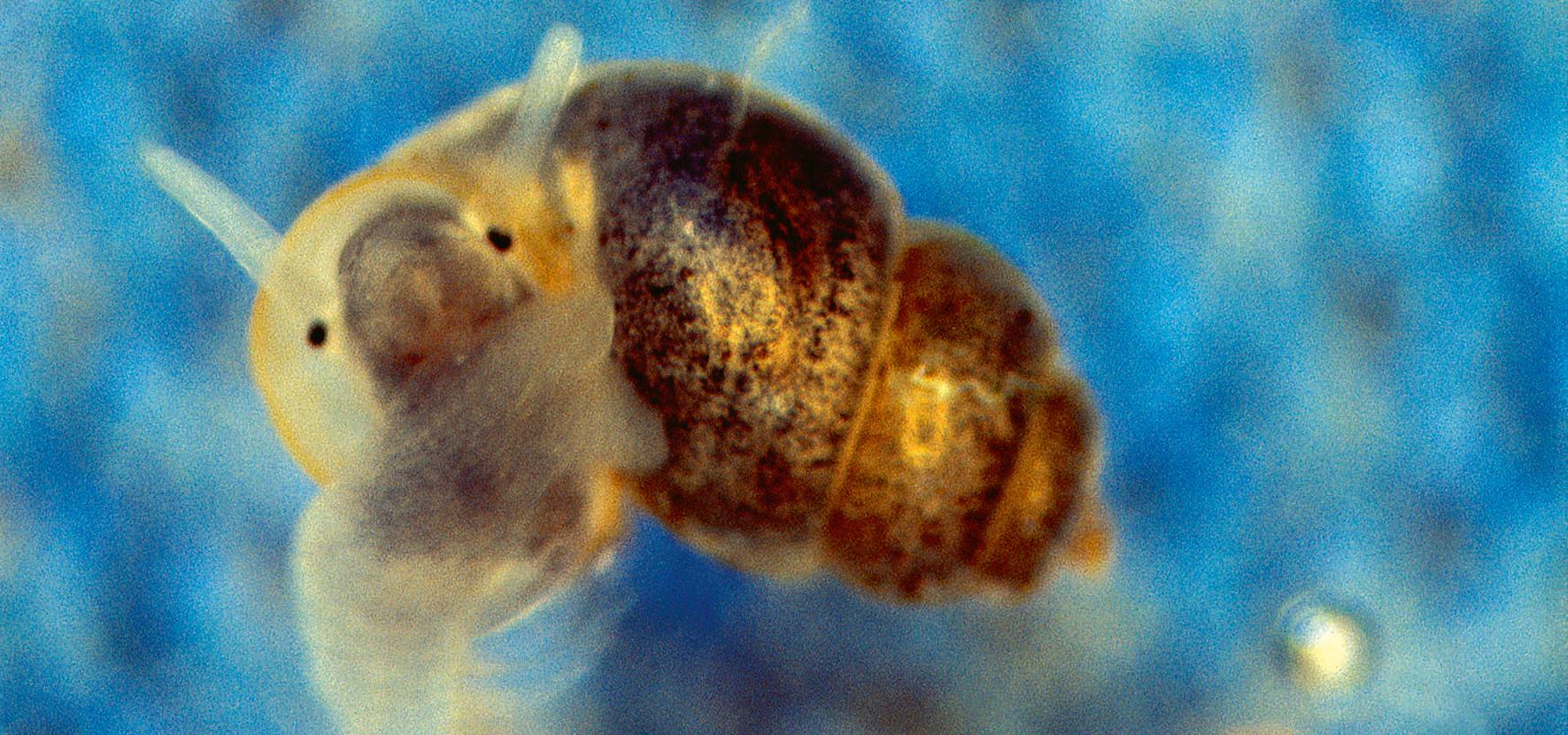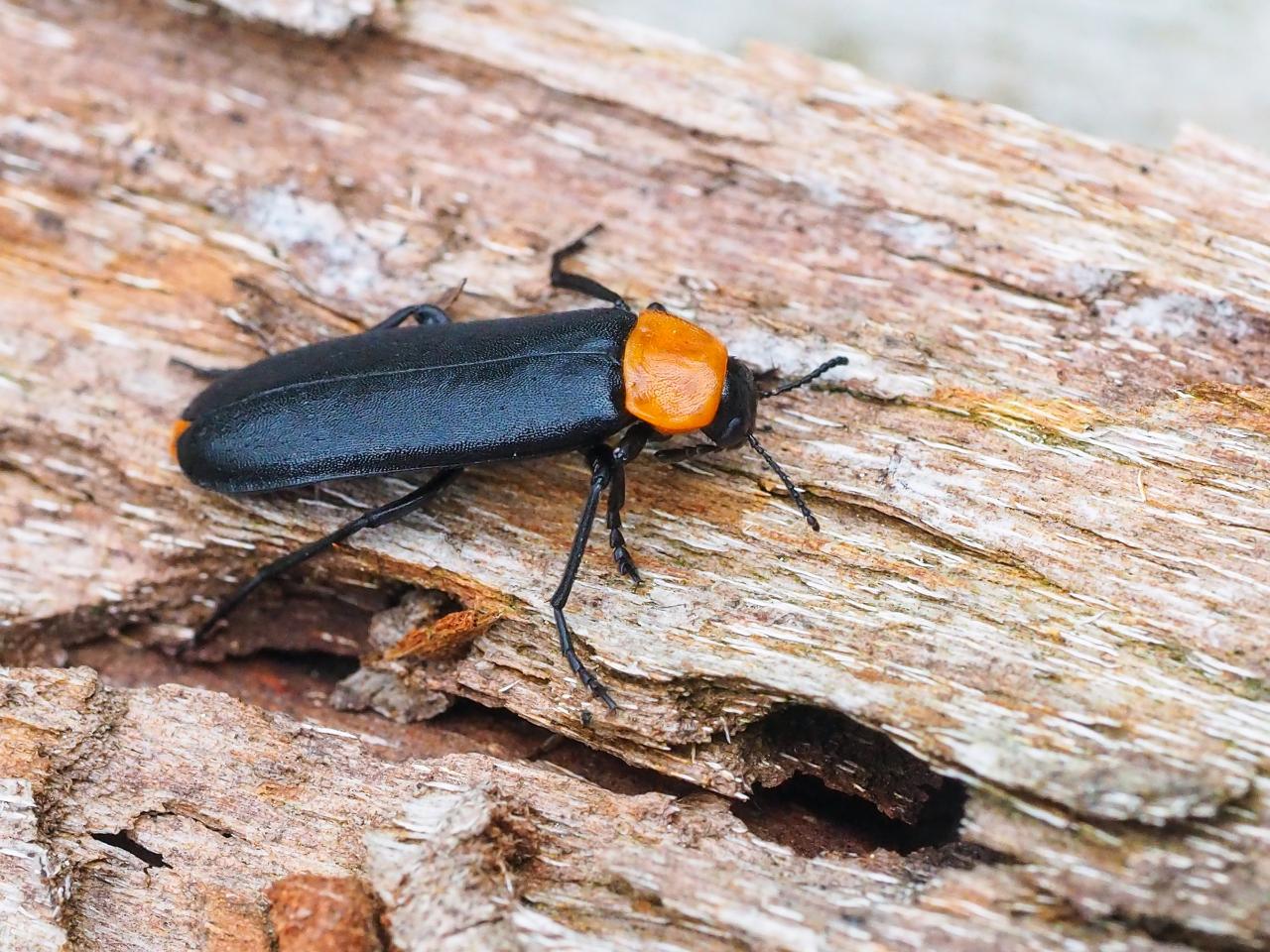The Kalkalpen National Park
- an endemic kingdom

Endemic beetle fauna
in the Kalkalpen National Park
With 174 known species and subspecies, the animal order of beetles (Coleoptera) is by far the largest group within Austria's endemic fauna. Of these, a very impressive 31 beetles (around 18 %) have also been recorded in Kalkalpen National Park , 13 of which are native only to Austria, without exception. For 18 others, at least 75 % of the distribution area is on Austrian territory. In addition, a further 14 endemic beetles have been confirmed for the protected area, at least 33% of whose total distribution area is on Austrian territory.
With a total of 45 known endemic species and a further 5 expected endemic species, Kalkalpen National Park and the Sengsengebirge in particular are among the most endemic areas in the Alps. Within Austria, due to their geographical location, only the higher mountain ranges in the immediate vicinity (especially Totes Gebirge, Haller Mauern, Gesäuse) have slightly higher numbers of species. Thus
the endemic beetle fauna alone shows that the Kalkalpen National Park fulfills its purpose as a protected area in the literal sense, i.e. as a refuge for sensitive and valuable species.
Probably the most important and also most famous endemic beetle of the Kalkalpen National Park is the cave ground beetle Arctaphaenops muellneri, whose distribution area (Sengsengebirge, Reichraminger Hintergebirge and Mollner Vorberge) lies primarily within the borders of the Kalkalpen National Park and thus exclusively in Upper Austria. A number of other locally endemic beetle species are only known from a few neighboring locations worldwide outside of the Kalkalpen National Park . These include Schauberger's weevil(Otiorhynchus schaubergeri), the extremely rare Austrian bearded beetle(Leistus austriacus) and the line-dotted beetle(Pterostichus lineatopunctatus).
The Kalkalpen National Park is a particularly important conservation area for these unique Austrian natural treasures. However, this also results in a high level of responsibility towards these specialists. The conservation of these species depends on the preservation of their habitats, but also on further research. Only if extensive knowledge about the special requirements, way of life and exact occurrence of a species is known can it be effectively protected and new challenges such as climate change or the accumulation of pollutants in the Alpine region be met.
Species list beetles endemics
List of 45 endemics detected in Kalkalpen National Park and 5 other endemics potentially expected for the protected area but not yet confirmed (1-48). Endemite criteria: Austrian endemic (E), subendemic (S), transnational endemic (T), and Alpine endemic (A). Conservation responsibility for Austria: (!) - to a high degree, (!!) - to a particularly high degree, (!!!) to an extremely high degree.
No. |
Species/Subspecies |
Family |
German family |
Status |
Responsibility |
| 1 | Amara cuniculina Dejean, 1831 | Carabidae | Ground beetle | E | !!! |
| 2 | Arctaphaenops muellneri Schmid, 1972 | Carabidae | Ground beetle | E | !!! |
| 3 | Leistus austriacus Schauberger, 1925 | Carabidae | Ground beetle | E | !!! |
| 4 | Nebria hellwigii chalcicola Franz, 1949 | Carabidae | Ground beetle | E | !!! |
| 5 | Pterostichus lineatopunctatus L. Miller, 1850 | Carabidae | Ground beetle | E | !!! |
| 6 | Pterostichus selmanni selmanni (Duftschmid, 1812) | Carabidae | Ground beetle | E | !!! |
| 7 | Trechus ovatus ovatus Putzeys, 1846 | Carabidae | Ground beetle | E | !!! |
| 8 | Trechus wagneri Ganglbauer, 1906 | Carabidae | Ground beetle | E | !!! |
| 9 | Dichotrachelus vulpinus kraussi Penecke, 1894 | Curculionidae | Weevil | E | !!! |
| 10 | Otiorhynchus schaubergeri Lona, 1923 | Curculionidae | Weevil | E | !!! |
| 11 | Tropiphorus styriacus Bedel, 1883 | Curculionidae | Weevil | E | !!! |
| 12 | Aphodius montivagus Erichson, 1848 | Scarabaeidae | Leaf horned beetle | E | !!! |
| 13 | Leptusa gracilipes Krauss, 1899 | Staphylinidae | Short-winged beetle | E | !!! |
| 14 | Carabus alpestris alpestris Sturm, 1815 | Carabidae | Ground beetle | S | !! |
| 15 | Carabus auronitens intercostatus Gredler, 1854 | Carabidae | Ground beetle | S | !! |
| 16 | Carabus sylvestris haberfelneri Ganglbauer, 1891 | Carabidae | Ground beetle | S | !! |
| 17 | Nebria germari norica Schauberger, 1927 | Carabidae | Ground beetle | S | !! |
| 18 | Oreonebria austriaca (Ganglbauer, 1889) | Carabidae | Ground beetle | S | !! |
| 19 | Pterostichus illigeri (Panzer, 1803) | Carabidae | Ground beetle | S | !! |
| 20 | Pterostichus panzeri (Panzer, 1803) | Carabidae | Ground beetle | S | !! |
| 21 | Pterostichus subsinuatus (Dejean, 1828) | Carabidae | Ground beetle | S | !! |
| 22 | Trechus alpicola alpicola Sturm, 1825 | Carabidae | Ground beetle | S | !! |
| 23 | Trechus hampei Ganglbauer, 1891 | Carabidae | Ground beetle | S | !! |
| 24 | Trechus pinkeri Ganglbauer, 1891 | Carabidae | Ground beetle | S | !! |
| 25 | Trechus rotundipennis (Duftschmid, 1812) | Carabidae | Ground beetle | S | !! |
| 26 | Oreina plagiata commutata (Suffrian, 1861) | Chrysomelidae | Leaf beetle | S | !! |
| 27 | Psylliodes subaeneus styriacus Heikertinger, 1921 | Chrysomelidae | Leaf beetle | S | !! |
| 28 | Brachiodontus alpinus (Hampe, 1867) | Curculionidae | Weevil | S | !! |
| 29 | Otiorhynchus nocturnus Reitter, 1913 | Curculionidae | Weevil | S | !! |
| 30 | Otiorhynchus pigrans Stierlin, 1861 | Curculionidae | Weevil | S | !! |
| 31 | Rhinomias austriacus (Reitter, 1894) | Curculionidae | Weevil | S | !! |
| 32 | Hydraena alpicola Pretner, 1931 | Hydraenidae | Long-tailed water beetle | S | !! |
| 33 | Lathrobium testaceum Kraatz, 1857 | Staphylinidae | Short-winged beetle | S | !! |
| 34 | Malthodes subductus Kiesenwetter, 1863 | Cantharidae | Soft-bodied beetle | T | ! |
| 35 | Carabus fabricii fabricii Duftschmid, 1812 | Carabidae | Ground beetle | T | ! |
| 36 | Patrobus styriacus Chaudoir, 1871 | Carabidae | Ground beetle | T | ! |
| 37 | Pterostichus jurinei jurinei (Panzer, 1803) | Carabidae | Ground beetle | T | ! |
| 38 | Pterostichus transversalis (Duftschmid, 1812) | Carabidae | Ground beetle | T | ! |
| 39 | Euconnus carinthiacus Ganglbauer, 1896 | Scydmaenidae | Short-winged beetle | T | ! |
| 40 | Aleochara ganglbaueri Bernhauer, 1901 | Staphylinidae | Short-winged beetle | T | ! |
| 41 | Bryaxis bothrophorus (Stolz, 1917) | Staphylinidae | Short-winged beetle | T | ! |
| 42 | Oreonebria castanea (Bonelli, 1810) | Carabidae | Ground beetle | A | ! |
| 43 | Aleochara meschniggi Bernhauer, 1901 | Staphylinidae | Short-winged beetle | A | ! |
| 44 | Eusphalerum nitidicolle (Baudi, 1857) | Staphylinidae | Short-winged beetle | A | ! |
| 45 | Leptusa globulicollis (Mulsant & Rey, 1853) | Staphylinidae | Short-winged beetle | A | ! |
| 46 | Leptusa piceata (Mulsant & Rey, 1853) | Staphylinidae | Short-winged beetle | A | ! |
| 47 | Ocypus brevipennis (Heer, 1839) | Staphylinidae | Short-winged beetle | A | ! |
Confirmed primeval forest relic beetle species
Species list of the beetle fauna
Data: A. Eckelt, H. Mitter & E. Weigand (2023); number of records: Locations in Kalkalpen National Park, without indication of the number of individuals observed
No. |
primeval forest-Relict types (scientific) |
Family (scientific) |
Family (German) |
Cat. |
First detection NP |
Evidence |
| 1 | Ampedus carpathicus (=suecicus) | Elateridae | Click beetle | 1 | 2019 | 2 |
| 2 | Bius thoracicus | Tenebrionidae | Black beetle | 1 | 2004 | 3 |
| 3 | Bolitophagus interruptus | Tenebrionidae | Black beetle | 1 | 2019 | 1 |
| 4 | Calitys scabra | Trogossitidae | Hunting beetle, flat beetle | 1 | 1982 | 6 |
| 5 | Ischnodes sanguinicollis | Elateridae | Click beetle | 1 | 2019 | 1 |
| 6 | Lacon lepidopterus | Elateridae | Click beetle | 1 | 2018 | 3 |
| 7 | Peltis grossa | Trogossitidae | Hunting beetle, flat beetle | 1 | 2010 | 27 |
| 8 | Phryganophilus ruficollis | Melandryidae | Darkling beetle | 1 | 2019 | 3 |
| 9 | Stictoleptura erythroptera | Cerambycidae | Longhorn beetle | 1 | 2019 | 1 |
| 10 | Allecula rhenana | Tenebrionidae | Black beetle | 2 | 2019 | 2 |
| 11 | Ampedus auripes | Elateridae | Click beetle | 2 | 2010 | 3 |
| 12 | Ampedus melanurus | Elateridae | Click beetle | 2 | 2019 | 2 |
| 13 | Cerophytum elateroides | Cerophytidae | click beetle-like | 2 | 2019 | 1 |
| 14 | Ceruchus chrysomelinus | Lucanidae | Stag beetle | 2 | 1977 | 12 |
| 15 | Crepidophorus mutilatus | Elateridae | Click beetle | 2 | 2015 | 1 |
| 16 | Cryptophagus lysholmi | Cryptophagidae | Mold beetle | 2 | 2011 | 1 |
| 17 | Derodontus macularis | Derodontidae | Larch beetle | 2 | 2015 | 1 |
| 18 | Dicerca berolinensis | Buprestidae | jewel beetle | 2 | 2019 | 7 |
| 19 | Dircaea australis | Melandryidae | Darkling beetle | 2 | 2011 | 7 |
| 20 | Ernobius explanatus | Anobiidae | Poching beetle | 2 | 2010 | 3 |
| 21 | Gnorimus variabilis | Scarabaeidae | Leaf horned beetle | 2 | 2019 | 1 |
| 22 | Grynocharis oblonga | Trogossitidae | Hunting beetle, flat beetle | 2 | 2019 | 1 |
| 23 | Hexarthrum duplicatum | Curculionidae | Weevil | 2 | 2015 | 1 |
| 24 | Latridius brevicollis | Latridiidae | Fashion beetle | 2 | 2010 | 1 |
| 25 | Leiestes seminiger | Endomychidae | Squirrel beetle | 2 | 2019 | 1 |
| 26 | Lordithon speciosus | Staphylinidae | Short winged | 2 | 2010 | 2 |
| 27 | Mycetochara obscura | Tenebrionidae | Black beetle | 2 | 2018 | 1 |
| 28 | Mycetoma suturale | Tetratomidae | Cull beetle | 2 | 2015 | 2 |
| 29 | Mycetophagus decempunctatus | Mycetophagidae | Dry rot beetle | 2 | 2019 | 1 |
| 30 | Nematodes filum | Eucnemidae | Comb beetle | 2 | 2009 | 7 |
| 31 | Phymatura brevicollis | Staphylinidae | Short winged | 2 | 2012 | 1 |
| 32 | Prionychus melanarius | Tenebrionidae | Black beetle | 2 | 2012 | 5 |
| 33 | Prostomis mandibularis | Prostomidae | Shovel beetle | 2 | 2011 | 8 |
| 34 | Quedius truncicola | Staphylinidae | Short winged | 2 | 2019 | 2 |
| 35 | Rhizophagus brancsiki | Monotomidae | Root beetle | 2 | 2019 | 1 |
| 36 | Rosalia alpina | Cerambycidae | Longhorn beetle | 2 | 1968 | 25 |
| 37 | Stephanopachys substriatus | Bostrichidae | Boring beetle | 2 | 2004 | 1 |
| 38 | Synchita separanda | Zopheridae | Bark beetle | 2 | 2010 | 7 |
| 39 | Tragosoma depsarium | Cerambycidae | Longhorn beetle | 2 | 1985 | 3 |
| 40 | Triplax collaris | Erotylidae | Fungus beetle | 2 | 2019 | 1 |
| 41 | Xestobium austriacum | Anobiidae | Poching beetle | 2 | 2010 | 6 |

Endangered butterfly species
Endangered species in Austria with occurrence in Kalkalpen National Park
Listing of selected species occurring in Kalkalpen National Park which are listed as endangered (VU), critically endangered (EN) or even threatened with extinction (CR) in the Red List of endangered butterflies and moths in Austria (excluding moths). The number of previous records in the national park area is also listed.
German species name |
Red List Austria |
Evidence |
| Large Papperglucke | CR | 1 |
| Yellow ringed butterfly | EN | 91 |
| Ash fritillary | EN | 49 |
| Light gray gray owl | EN | 6 |
| Heilziest butterfly | EN | 5 |
| Bedstraw hawkmoth | EN | 1 |
| Small hop rootworm | EN | 1 |
| Gray fashionable wood owl | EN | 1 |
| Scalloped bear | VU | 48 |
| Augsburg bear | VU | 43 |
| Elegant daisy | VU | 31 |
| Plum jelly | VU | 30 |
| Purple bear | VU | 14 |
| Platinum gray tufted owl | VU | 5 |
| Sunflower fritillary butterfly | VU | 5 |
| Rockland burrowing owl | VU | 5 |
| Elm tip butterfly | VU | 4 |
| Plague root rot | VU | 3 |
| Spotted fritillary | VU | 3 |
| Meadow dusty owl | VU | 2 |
| Ruderal Field Scops Owl | VU | 2 |
| Large kingfisher | VU | 2 |
| Simulans ground owl | VU | 2 |
| Alexis blue, sky-blue Seinklee blue | VU | 1 |
| Gray lichen owl | VU | 1 |
| Dry grassland ground owl | VU | 1 |
| Common knapweed | VU | 1 |
| Small sainfoin blue | VU | 1 |
| Round-spotted cube fritillary | VU | 1 |
| Rocky scrubland burrowing owl | VU | 1 |
| Sainfoin Oriole | VU | 1 |
| Plantain Fritillary | VU | 1 |

Endemic spring snail species
The primary aim of this project was to identify the species of spring snails (hydrobioids: dwarf snails) found in the area, the majority of which are endemic. The majority of this species group, which is widespread in karst spring biotopes and underground waters in the Northern Limestone Alps, cannot be reliably identified to species level on the basis of morphological characteristics and requires genetic analyses. However, knowledge of the species status is essential, as endemic species are usually distributed on an extremely small scale and the majority are also under strict conservation protection. The genetic analysis as well as other classical methods for species determination were carried out under a contract for work by employees of the Natural History Museum Vienna (laboratory & ABOL project management: Dr. Luise Kruckenhauser, head of the mollusc collection and project coordination: Anita Eschner, project implementation: Hannah Schubert, as well as the involved experts Dr. Michael Duda and Dr. Martin Haase).
100 DNA barcodes were created on individuals from 39 spring biotopes. The results confirm that extremely rare hydrobioids, which are particularly worthy of protection due to their endemic status, occur in selected spring biotopes in the region of the national park and therefore require special protection. This applies in particular to the two species Belgrandiella aulaei and Bythiospeum nocki, which have so far only been recorded worldwide in Kalkalpen National Park and its immediate surroundings.
Spring snail species (scientific) |
|
| Belgrandiella aulaei | |
| Bythiospeum nocki | |
| Bythinella concia | |
| Hauffenia kerschneri | |
| Hauffenia wienerwaldensis |



